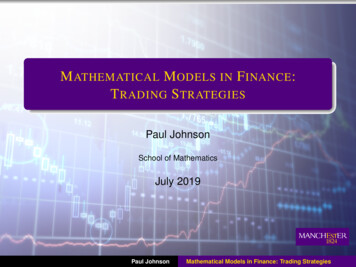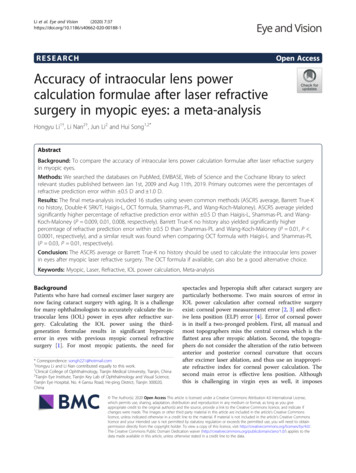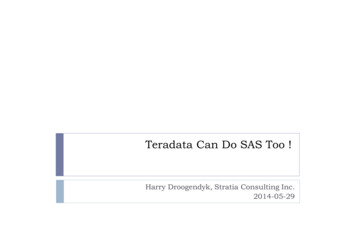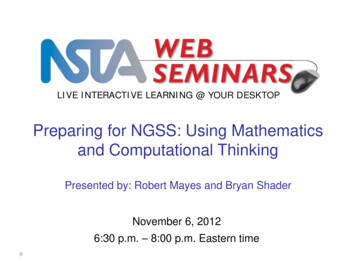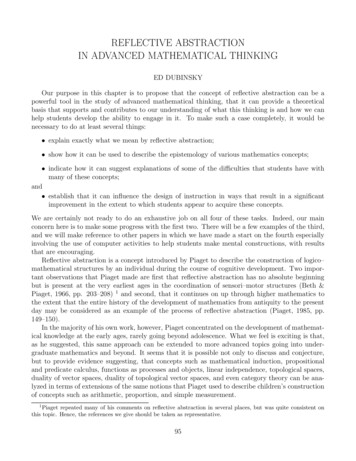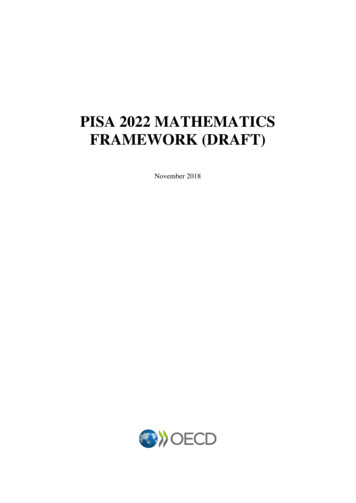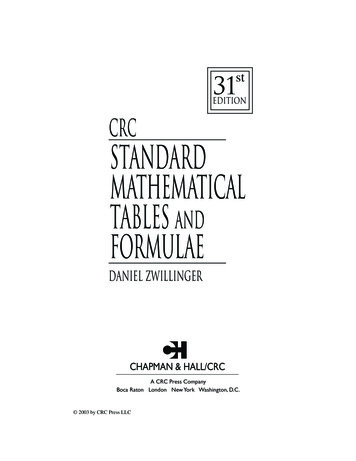
Transcription
st31EDITIONCRCstandardMathematicALTABLES andformulaeDANIEL ZWILLINGERCHAPMAN & HALL/CRCA CRC Press CompanyBoca Raton London New York Washington, D.C. 2003 by CRC Press LLC
Editor-in-ChiefDaniel ZwillingerRensselaer Polytechnic InstituteTroy, New YorkAssociate EditorsSteven G. KrantzWashington UniversitySt. Louis, MissouriKenneth H. RosenAT&T Bell LaboratoriesHolmdel, New JerseyEditorial Advisory BoardGeorge E. AndrewsPennsylvania State UniversityUniversity Park, PennsylvaniaBen FusaroFlorida State UniversityTallahassee, FloridaMichael F. BridglandCenter for Computing SciencesBowie, MarylandAlan F. KarrNational Institute Statistical SciencesResearch Triangle Park, North CarolinaJ. Douglas FairesYoungstown State UniversityYoungstown, OhioAl MardenUniversity of MinnesotaMinneapolis, MinnesotaGerald B. FollandUniversity of WashingtonSeattle, WashingtonWilliam H. PressLos Alamos National LabLos Alamos, NM 87545 2003 by CRC Press LLC
PrefaceIt has long been the established policy of CRC Press to publish, in handbook form,the most up-to-date, authoritative, logically arranged, and readily usable referencematerial available. Prior to the preparation of this 31 st Edition of the CRC StandardMathematical Tables and Formulae, the content of such a book was reconsidered.The previous edition was carefully analyzed, and input was obtained from practitioners in the many branches of mathematics, engineering, and the physical sciences.The consensus was that numerous small additions were required in several sections,and several new areas needed to be added.Some of the new materials included in this edition are: game theory and votingpower, heuristic search techniques, quadratic elds, reliability, risk analysis and decision rules, a table of solutions to Pell’s equation, a table of irreducible polynomialsin ¾ , a longer table of prime numbers, an interpretation of powers of 10, a collection of “proofs without words”, and representations of groups of small order. Intotal, there are more than 30 completely new sections, more than 50 new and modi ed entries in the sections, more than 90 distinguished examples, and more than adozen new tables and gures. This brings the total number of sections, sub-sections,and sub-sub-sections to more than 1,000. Within those sections are now more than3,000 separate items (a de nition , a fact, a table, or a property). The index has alsobeen extensively re-worked and expanded to make nding results faster and easier;there are now more than 6,500 index references (with 75 cross-references of terms)and more than 750 notation references.The same successful format which has characterized earlier editions of the Handbook is retained, while its presentation has been updated and made more consistentfrom page to page. Material is presented in a multi-sectional format, with each section containing a valuable collection of fundamental reference material—tabular andexpository.In line with the established policy of CRC Press, the Handbook will be kept ascurrent and timely as is possible. Revisions and anticipated uses of newer materialsand tables will be introduced as the need arises. Suggestions for the inclusion of newmaterial in subsequent editions and comments regarding the present edition are welcomed. The home page for this book, which will include errata, will be maintainedat http://www.mathtable.com/. The major material in this new edition is as follows:Chapter 1: Analysis begins with numbers and then combines them into series andproducts. Series lead naturally into Fourier series. Numbers also lead to functions which results in coverage of real analysis, complex analysis, and generalized functions.Chapter 2: Algebra covers the different types of algebra studied: elementary algebra, vector algebra, linear algebra, and abstract algebra. Also included aredetails on polynomials and a separate section on number theory. This chapterincludes many new tables.Chapter 3: Discrete Mathematics covers traditional discrete topics such as combinatorics, graph theory, coding theory and information theory, operations re- 2003 by CRC Press LLC
search, and game theory. Also included in this chapter are logic, set theory,and chaos.Chapter 4: Geometry covers all aspects of geometry: points, lines, planes, surfaces, polyhedra, coordinate systems, and differential geometry.Chapter 5: Continuous Mathematics covers calculus material: differentiation, integration, differential and integral equations, and tensor analysis. A large tableof integrals is included. This chapter also includes differential forms and orthogonal coordinate systems.Chapter 6: Special Functions contains a sequence of functions starting with thetrigonometric, exponential, and hyperbolic functions, and leading to many ofthe common functions encountered in applications: orthogonal polynomials,gamma and beta functions, hypergeometric functions, Bessel and elliptic functions, and several others. This chapter also contains sections on Fourier andLaplace transforms, and includes tables of these transforms.Chapter 7: Probability and Statistics begins with basic probability information (de n ing several common distributions) and leads to common statistical needs (pointestimates, con d ence intervals, hypothesis testing, and ANOVA). Tables of thenormal distribution, and other distributions, are included. Also included in thischapter are queuing theory, Markov chains, and random number generation.Chapter 8: Scientific Computing explores numerical solutions of linear and nonlinear algebraic systems, numerical algorithms for linear algebra, and how tonumerically solve ordinary and partial differential equations.Chapter 9: Financial Analysis contains the formulae needed to determine the return on an investment and how to determine an annuity (i.e., the cost of amortgage). Numerical tables covering common values are included.Chapter 10: Miscellaneous contains details on physical units (de nition s and conversions), formulae for date computations, lists of mathematical and electronicresources, and biographies of famous mathematicians.It has been exciting updating this edition and making it as useful as possible.But it would not have been possible without the loving support of my family, JanetTaylor and Kent Taylor Zwillinger.Daniel Zwillinger 15 October 2002 2003 by CRC Press LLC
ContributorsKaren BolingerClarion UniversityClarion, PennsylvaniaWilliam C. RinamanLeMoyne CollegeSyracuse, New YorkPatrick J. DriscollU.S. Military AcademyWest Point, New YorkCatherine RobertsCollege of the Holy CrossWorcester, MassachusettsM. Lawrence GlasserClarkson UniversityPotsdam, New YorkJeff GoldbergUniversity of ArizonaTucson, ArizonaRob GrossBoston CollegeChestnut Hill, MassachusettsGeorge W. HartSUNY Stony BrookStony Brook, New YorkMelvin HausnerCourant Institute (NYU)New York, New YorkVictor J. KatzMAAWashington, DCSilvio LevyMSRIBerkeley, CaliforniaMichael MascagniFlorida State UniversityTallahassee, FloridaRay McLenaghanUniversity of WaterlooWaterloo, Ontario, CanadaJoseph J. RushananMITRE CorporationBedford, MassachusettsLes ServiMIT Lincoln LaboratoryLexington, MassachusettsPeter SherwoodInteractive Technology, Inc.Newton, MassachusettsNeil J. A. SloaneAT&T Bell LabsMurray Hill, New JerseyCole SmithUniversity of ArizonaTucson, ArizonaMike SousaVeridianAnn Arbor, MichiganGary L. StanekYoungstown State UniversityYoungstown, OhioMichael T. StraussHMENewburyport, MassachusettsJohn MichaelsSUNY BrockportBrockport, New YorkNico M. TemmeCWIAmsterdam, The NetherlandsRoger B. NelsenLewis & Clark CollegePortland, OregonAhmed I. ZayedDePaul UniversityChicago, Illinois 2003 by CRC Press LLC
Table of ContentsChapter 1Analysis Chapter 2Algebra Karen Bolinger, M. Lawrence Glasser, Rob Gross, andNeil J. A. Sloane Patrick J. Driscoll, Rob Gross, John Michaels, Roger B.Nelsen, and Brad WilsonChapter 3Discrete Mathematics Jeff Goldberg, Melvin Hausner,Joseph J. Rushanan, LesServi, and Cole SmithChapter 4Geometry George W. Hart, Silvio Levy, and Ray McLenaghanChapter 5Continuous Mathematics Nico M. Temme and Ahmed I. ZayedChapter 7Probability and Statistics Gary StanekChapter 9Financial Analysis Daniel ZwillingerChapter 10Miscellaneous Michael Mascagni, William C. Rinaman, Mike Sousa, andMichael T. StraussChapter 8Scientific Computing Ray McLenaghan and Catherine RobertsChapter 6Special Functions Rob Gross, Victor J. Katz, and Michael T. Strauss 2003 by CRC Press LLC
Table of ContentsChapter 1Analysis 1.1Constants . . . . . . . .1.2Special numbers . . . . .1.3Series and products . . .1.4Fourier series . . . . . .1.5Complex analysis . . . .1.6Interval analysis . . . . .1.7Real analysis . . . . . . .1.8Generalized functions . . Chapter 2Algebra 2.1Proofs without words . .2.2Elementary algebra . . .2.3Polynomials . . . . . . .2.4Number theory . . . . . .2.5Vector algebra . . . . . .2.6Linear and matrix algebra2.7Abstract algebra . . . . . .Chapter 3Discrete Mathematics 3.1Symbolic logic3.2Set theory . . . . . . . . . . . . . . .3.3Combinatorics . . . . . . . . . . . . .3.4Graphs . . . . . . . . . . . . . . . . .3.5Combinatorial design theory . . . . .3.6Communication theory . . . . . . . .3.7Difference equations . . . . . . . . . .3.8Discrete dynamical systems and chaos3.9Game theory . . . . . . . . . . . . . .3.10 Operations research . . . . . . . . . .Chapter 4Geometry 4.1Coordinate systems in the plane . .4.2Plane symmetries or isometries . .4.3Other transformations of the plane4.4Lines . . . . . . . . . . . . . . . . 2003 by CRC Press LLC. . .
84.194.204.214.22Polygons . . . . . . . . . . . . . . . .Conics . . . . . . . . . . . . . . . . .Special plane curves . . . . . . . . . .Coordinate systems in space . . . . .Space symmetries or isometries . . . .Other transformations of space . . . .Direction angles and direction cosinesPlanes . . . . . . . . . . . . . . . . .Lines in space . . . . . . . . . . . . .Polyhedra . . . . . . . . . . . . . . .Cylinders . . . . . . . . . . . . . . .Cones . . . . . . . . . . . . . . . . .Surfaces of revolution: the torus . . .Quadrics . . . . . . . . . . . . . . . .Spherical geometry & trigonometry . .Differential geometry . . . . . . . . .Angle conversion . . . . . . . . . . .Knots up to eight crossings . . . . . .Chapter 5Continuous Mathematics 5.1Differential calculus . . . . . .5.2Differential forms . . . . . . .5.3Integration . . . . . . . . . . .5.4Table of inde n ite integrals . .5.5Table of de nite integrals . . .5.6Ordinary differential equations5.7Partial differential equations . .5.8Eigenvalues . . . . . . . . . .5.9Integral equations . . . . . . .5.10 Tensor analysis . . . . . . . .5.11 Orthogonal coordinate systems5.12 Control theory . . . . . . . . . .Chapter 6Special Functions 6.1Trigonometric or circular functions . .6.2Circular functions and planar triangles6.3Inverse circular functions . . . . . . .6.4Ceiling and oor functions . . . . . .6.5Exponential function . . . . . . . . .6.6Logarithmic functions . . . . . . . . .6.7Hyperbolic functions . . . . . . . . .6.8Inverse hyperbolic functions . . . . .6.9Gudermannian function . . . . . . . .6.10 Orthogonal polynomials . . . . . . . . 2003 by CRC Press LLC. .
236.246.256.266.276.286.296.306.316.326.33Gamma function . . . . . . . . . . . .Beta function . . . . . . . . . . . . .Error functions . . . . . . . . . . . . .Fresnel integrals . . . . . . . . . . . .Sine, cosine, and exponential integralsPolylogarithms . . . . . . . . . . . . .Hypergeometric functions . . . . . . .Legendre functions . . . . . . . . . .Bessel functions . . . . . . . . . . . .Elliptic integrals . . . . . . . . . . . .Jacobian elliptic functions . . . . . . .Clebsch–Gordan coef cients . . . . .Integral transforms: Preliminaries . . .Fourier transform . . . . . . . . . . .Discrete Fourier transform (DFT) . . .Fast Fourier transform (FFT) . . . . .Multidimensional Fourier transform .Laplace transform . . . . . . . . . . .Hankel transform . . . . . . . . . . .Hartley transform . . . . . . . . . . .Hilbert transform . . . . . . . . . . .-Transform . . . . . . . . . . . . . .Tables of transforms . . . . . . . . . .Chapter 7Probability and Statistics 7.1Probability theory . . . . . . . .7.2Classical probability problems .7.3Probability distributions . . . . .7.4Queuing theory . . . . . . . . .7.5Markov chains . . . . . . . . . .7.6Random number generation . . .7.7Control charts and reliability . .7.8Risk analysis and decision rules .7.9Statistics . . . . . . . . . . . . .7.10 Con de nce intervals . . . . . . .7.11 Tests of hypotheses . . . . . . .7.12 Linear regression . . . . . . . .7.13 Analysis of variance (ANOVA) .7.14 Probability tables . . . . . . . .7.15 Signal processing . . . . . . . . .Chapter 8Scienti c Computing 8.1Basic numerical analysis . . . . . . . . . . . . . . . . . . . . .8.2Numerical linear algebra . . . . . . . . . . . . . . . . . . . . . . 2003 by CRC Press LLC
8.38.4Numerical integration and differentiation . . . . . . . . . . . . . .Programming techniques . . . . . . . . . . . . . . . . . . . . . .Chapter 9Financial Analysis 9.1Financial formulae . . . . . . . . . . . . . . . . . . . . . . . . .9.2Financial tables . . . . . . . . . . . . . . . . . . . . . . . . . . .Chapter 10Miscellaneous 10.1 Units . . . . . . . . . . . . . . . . . . .10.2 Interpretations of powers of 10 . . . . .10.3 Calendar computations . . . . . . . . .10.4 AMS classi cation scheme . . . . . . .10.5 Fields medals . . . . . . . . . . . . . .10.6 Greek alphabet . . . . . . . . . . . . . .10.7 Computer languages . . . . . . . . . . .10.8 Professional mathematical organizations10.9 Electronic mathematical resources . . .10.10 Biographies of mathematicians . . . . .List of references . List of Figures List of notation 2003 by CRC Press LLC
List of ReferencesChapter 1Analysis1. J. W. Brown and R. V. Churchill, Complex variables and applications,6th edition, McGraw–Hill, New York, 1996.2. L. B. W. Jolley, Summation of Series, Dover Publications, New York,1961.3. S. G. Krantz, Real Analysis and Foundations, CRC Press, Boca Raton,FL, 1991.4. S. G. Krantz, The Elements of Advanced Mathematics, CRC Press, BocaRaton, FL, 1995.5. J. P. Lambert, “Voting Games, Power Indices, and Presidential Elections”, The UMAP Journal, Module 690, 9, No. 3, pages 214–267, 1988.6. L. D. Servi, “Nested Square Roots of 2”, American Mathematical Monthly,to appear in 2003.7. N. J. A. Sloane and S. Plouffe, Encyclopedia of Integer Sequences, Academic Press, New York, 1995.Chapter 2Algebra1. C. Caldwell and Y. Gallot, “On the primality of and ”, Mathematics of Computation, 71:237, pages 441–448, 2002.2. I. N. Herstein, Topics in Algebra, 2nd edition, John Wiley & Sons, NewYork, 1975.3. P. Ribenboim, The book of Prime Number Records, Springer–Verlag,New York, 1988.4. G. Strang, Linear Algebra and Its Applications, 3rd edition, InternationalThomson Publishing, 1988.Chapter 3Discrete Mathematics1. B. Bollobás, Graph Theory, Springer–Verlag, Berlin, 1979. 2003 by CRC Press LLC
2. C. J. Colbourn and J. H. Dinitz, Handbook of Combinatorial Designs,CRC Press, Boca Raton, FL, 1996.3. F. Glover, “Tabu Search: A Tutorial”, Interfaces, 20(4), pages 74–94,1990.4. D. E. Goldberg, Genetic Algorithms in Search, Optimization, and Machine Learning, Addison–Wesley, Reading, MA, 1989.5. J. Gross, Handbook of Graph Theory & Applications, CRC Press, BocaRaton, FL, 1999.6. D. Luce and H. Raiffa, Games and Decision Theory, Wiley, 1957.7. F. J. MacWilliams and N. J. A. Sloane, The Theory of Error-CorrectingCodes, North–Holland, Amsterdam, 1977.8. N. Metropolis, A. W. Rosenbluth, M. N. Rosenbluth, A. H. Teller and E.Teller, “Equation of State Calculations by Fast Computing Machines”, J.Chem. Phys., V 21, No. 6, pages 1087–1092, 1953.9. K. H. Rosen, Handbook of Discrete and Combinatorial Mathematics,CRC Press, Boca Raton, FL, 2000.10. J. O’Rourke and J. E. Goodman, Handbook of Discrete and Computational Geometry, CRC Press, Boca Raton, FL, 1997.Chapter 4Geometry1. A. Gray, Modern Differential Geometry of Curves and Surfaces, CRCPress, Boca Raton, FL, 1993.2. C. Livingston, Knot Theory, The Mathematical Association of America,Washington, D.C., 1993.3. D. J. Struik, Lectures in Classical Differential Geometry, 2nd edition,Dover, New York, 1988.Chapter 5Continuous Mathematics1. A. G. Butkovskiy, Green’s Functions and Transfer Functions Handbook,Halstead Press, John Wiley & Sons, New York, 1982.2. I. S. Gradshteyn and M. Ryzhik, Tables of Integrals, Series, and Products, edited by A. Jeffrey and D. Zwillinger, 6th edition, Academic Press,Orlando, Florida, 2000.3. N. H. Ibragimov, Ed., CRC Handbook of Lie Group Analysis of Differential Equations, Volume 1, CRC Press, Boca Raton, FL, 1994.4. A. J. Jerri, Introduction to Integral Equations with Applications, MarcelDekker, New York, 1985.5. P. Moon and D. E. Spencer, Field Theory Handbook, Springer-Verlag,Berlin, 1961.6. A. D. Polyanin and V. F. Zaitsev, Handbook of Exact Solution for Ordinary Differential Equations, CRC Press, Boca Raton, FL, 1995. 2003 by CRC Press LLC
7. J. A. Schouten, Ricci-Calculus, Springer–Verlag, Berlin, 1954.8. J. L. Synge and A. Schild, Tensor Calculus, University of Toronto Press,Toronto, 1949.9. D. Zwillinger, Handbook of Differential Equations, 3rd ed., AcademicPress, New York, 1997.10. D. Zwillinger, Handbook of Integration, A. K. Peters, Boston, 1992.Chapter 6Special Functions1. Staff of the Bateman Manuscript Project, A. Erdélyi, Ed., Tables of Integral Transforms, in 3 volumes, McGraw–Hill, New York, 1954.2. I. S. Gradshteyn and M. Ryzhik, Tables of Integrals, Series, and Products, edited by A. Jeffrey and D. Zwillinger, 6th edition, Academic Press,Orlando, Florida, 2000.3. W. Magnus, F. Oberhettinger, and R. P. Soni, Formulas and Theorems forthe Special Functions of Mathematical Physics, Springer–Verlag, NewYork, 1966.4. N. I. A. Vilenkin, Special Functions and the Theory of Group Representations, American Mathematical Society, Providence, RI, 1968.Chapter 7Probability and Statistics1. I. Daubechies, Ten Lectures on Wavelets, SIAM Press, Philadelphia, 1992.2. W. Feller, An Introduction to Probability Theory and Its Applications,Volume 1, John Wiley & Sons, New York, 1968.3. J. Keilson and L. D. Servi, “The Distributional Form of Little’s Lawand the Fuhrmann–Cooper Decomposition”, Operations Research Letters, Volume 9, pages 237–247, 1990.4. Military Standard 105 D, U.S. Government Printing Of ce, Washington,D.C., 1963.5. S. K. Park and K. W. Miller, “Random number generators: good ones arehard to nd”, Comm. ACM, October 1988, 31, 10, pages 1192–1201.6. G. Strang and T. Nguyen, Wavelets and Filter Banks, Wellesley–CambridgePress, Wellesley, MA, 1995.7. D. Zwillinger and S. Kokoska, Standard Probability and Statistics Tablesand Formulae, Chapman & Hall/CRC, Boca Raton, Florida, 2000.Chapter 8Scientific Computing1. R. L. Burden and J. D. Faires, Numerical Analysis, 7th edition, Brooks/Cole,Paci c Grove, CA, 2001.2. G. H. Golub and C. F. Van Loan, Matrix Computations, 2nd ed., TheJohns Hopkins Press, Baltimore, 1989. 2003 by CRC Press LLC
3. W. H. Press, S. A. Teukolsky, W. T. Vetterling, and B. P. Flannery, Numerical Recipes in C : The Art of Scientific Computing, 2nd edition,Cambridge University Press, New York, 2002.4. A. Ralston and P. Rabinowitz, A First Course in Numerical Analysis, 2ndedition, McGraw–Hill, New York, 1978.5. R. Rubinstein, Simulation and the Monte Carlo Method, Wiley, NewYork, 1981.Chapter 10Miscellaneous1. American Mathematical Society, Mathematical Sciences Professional Directory, Providence, 1995.2. E. T. Bell, Men of Mathematics, Dover, New York, 1945.3. C. C. Gillispie, Ed., Dictionary of Scientific Biography, Scribners, NewYork, 1970–1990.4. H. S. Tropp, “The Origins and History of the Fields Medal”, HistoriaMathematica, 3, pages 167–181, 1976.5. E. W. Weisstein, CRC Concise Encyclopedia of Mathematics, CRC Press,Boca Raton, FL, 1999. 2003 by CRC Press LLC
List of Figures2.1Depiction of right-hand rule3.13.23.33.43.53.63.73.8Hasse diagramsThree graphs that are isomorphicExamples of graphs with 6 or 7 verticesTrees with 7 or fewer verticesTrees with 8 verticesJulia setsThe Mandlebrot setDirected network modeling a flow 4.144.154.164.174.184.194.204.214.22Change of coordinates by a rotationCartesian coordinates: the 4 quadrantsPolar coordinatesHomogeneous coordinatesOblique coordinatesA shear with factor ½¾A perspective transformationThe normal form of a lineSimple polygonsNotation for a triangleTriangles: isosceles and rightCeva’s theorem and Menelaus’s theoremQuadrilateralsConics: ellipse, parabola, and hyperbolaConics as a function of eccentricityEllipse and componentsHyperbola and componentsArc of a circleAngles within a circleThe general cubic parabolaCurves: semi-cubic parabola, cissoid of Diocles, witch of AgnesiThe folium of Descartes in two positions, and the strophoid 2003 by CRC Press LLC
354.364.374.384.394.404.41Cassini’s ovalsThe conchoid of NichomedesThe limaçon of PascalCycloid and trochoidsEpicycloids: nephroid, and epicycloidHypocycloids: deltoid and astroidSpirals: Bernoulli, Archimedes, and CornuCartesian coordinates in spaceCylindrical coordinatesSpherical coordinatesRelations between Cartesian, cylindrical, and spherical coordinatesEuler anglesThe Platonic solidsCylinders: oblique and right circularRight circular cone and frustramA torus of revolutionThe ve nondegenerate real quadricsSpherical cap, zone, and segmentRight spherical triangle and Napier’s rule5.1Types of critical points6.16.26.36.46.56.66.76.86.96.10Notation for trigonometric functionsDefinitions of anglesSine and cosineTangent and cotangentDifferent triangles requiring solutionGraphs of and Cornu spiralSine and cosine integrals and Legendre functionsGraphs of the Airy functions and7.17.27.37.47.57.6Approximation to binomial distributionsConceptual layout of a queueSample size code letters for MIL-STD-105 DMaster table for single sampling inspection (normal inspection)Area of a normal random variableIllustration of and regions of a normal distribution8.18.28.3Illustration of Newton’s methodFormulae for integration rules with various weight functionsIllustration of the Monte–Carlo method 2003 by CRC Press LLC
List of Notation*Page numbers listed do not match PDF page numbers due to deletion of blank pages.Symbols! factorial . . . . . . . . . . . . . . . . . . . . . . . . . . 17!! double factorial . . . . . . . . . . . . . . . . . . 17tensor differentiation . . . . . . . . . . . . . 484tensor differentiation . . . . . . . . . . . . . 484 cyclic subgroup generated by . 162 set complement . . . . . . . . . . . . . . . . 203derivative, rst . . . . . . . . . . . . . . . . . . . 386derivative, second . . . . . . . . . . . . . . . 386 ceiling function . . . . . . . . . . . . . . . . 520 oor function . . . . . . . . . . . . . . . . . . 520 Stirling subset numbers . . . . . . . . 213 aleph null . . . . . . . . . . . . . . . . . . . . . 204 universal quanti er . . . . . . . . . . . . . . 201 arrow notation . . . . . . . . . . . . . . . . . . . . . 4if and only if . . . . . . . . . . . . . . . . . . . 199implies . . . . . . . . . . . . . . . . . . . . . . . . 199logical implication . . . . . . . . . . . . . .199set intersection . . . . . . . . . . . . . . . . . . 203 differentiation . . . . . . . . . . . . 386 partialdual code to. . . . . . . . . . . . . . . . 257 partial order . . . . . . . . . . . . . . . . . . . . 204 product symbol . . . . . . . . . . . . . . . . . . 47summation symbol . . . . . . . . . . . . . . 31 empty set . . . . . . . . . . . . . . . . . . . . . . . 202 asymptotic relation . . . . . . . . . . . . 75logical not . . . . . . . . . . . . . . . . . . . 199vertex similarity . . . . . . . . . . . . . . 226 logical or . . . . . . . . . . . . . . . . . . . . 199pseudoscalar product . . . . . . . . . 467 graph conjunction . . . . . . . . . . . . 228logical and . . . . . . . . . . . . . . . . . . 199wedge product . . . . . . . . . . . . . . . 395 graph edge sum . . . . . . . . . . . . . . 228graph union . . . . . . . . . . . . . . . . . .229set union . . . . . . . . . . . . . . . . . . . . 203 group isomorphism . . . . . . . . . 170, 225 congruence . . . . . . . . . . . . . . . . . . . . . . 94 existential quanti er . . . . . . . . . . . . . 201Plank constant over . . . . . . . . . . . 794 in nity . . . . . . . . . . . . . . . . . . . . . . . . . 68 de nite integral . . . . . . . . . . . 399integral around closed path . . 399integration symbol . . . . . . . . . . . 399 falling factorial . . . . . . . . . . . . . . . . . . 17 logical not . . . . . . . . . . . . . . . . . . . . . . 199 2003 by CRC Press LLCdivergence . . . . . . . . . . . . . . . 493 curl . . . . . . . . . . . . . . . . . . . . . 493 Laplacian . . . . . . . . . . . . . . . . 493backward difference . . . . . . . . . . 736gradient . . . . . . . . . . . . . . . . 390, 493linear connection . . . . . . . . . . . . . 484[]graph composition . . . . 228commutator . . . . . . . . . 155, 467 vuw scalar triple product . . . . 136 continued fraction . 96 Christoffel symbol, rst kind 487 Stirling cycle numbers . . . . 212
() poset notation . . . . . . . . . 205 shifted factorial . . . . . . . . . . 17 type of tensor . . . . . . . . 483 design nomenclature . 245 point in three-dimensionalspace . . . . . . . . . . . . . . . . . . 345 homogeneouscoordinates . . . . . . . . . . . . . 303 homogeneous coordinates . . . . . . . . . . . . . 3482222 crystallographic group . . 310333 crystallographic group . . . 311442 crystallographic group . . . 310632 crystallographic group . . . 311crystallographic group . . . . . 309binary operation . . . . . . . . . . . . . .160convolution operation . . . . . . . . . 579dual of a tensor . . . . . . . . . . . . . . 489group operation . . . . . . . . . . . . . . 161re ection . . . . . . . . . . . . . . . . . . . . 307 Clebsch–Gordancoef cient . . . . . . . . . . . . . . 574binomialcoef cient . . . . . . 208 multinomial½ ¾ coef cient . . . . . . . . . . . . . . 209 Jacobi symbol . . . . . . . . . . . . 94 Legendre symbol . . . . . . . . . 94 fourth derivative . . . . . . . . . . 386 th derivative . . . . . . . . . . . . . 386 fth derivative . . . . . . . . . . . . 386 a b vector cross product . . . . 135crystallographic group . . . . . 309crystallographic group . . . . 309glide-re ection . . . . . . . . . . . . . . . 307graph product . . . . . . . . . . . . . . . . 228group operation . . . . . . . . . . . . . . 161product . . . . . . . . . . . . . . . . . . . . . . . 66 Kronecker product . . . . . . . . . . . 159symmetric difference . . . . . . . . . 203exclusive o
Chapter 5: Continuous Mathematics covers calculus material: differentiation, in-tegration, differential and integral equations, and tensor analysis. A large table of integrals is included. This chapter also includes differential forms and or-thogonal coordinate systems. Chapter 6: Special Fun



